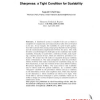Free Online Productivity Tools
i2Speak
i2Symbol
i2OCR
iTex2Img
iWeb2Print
iWeb2Shot
i2Type
iPdf2Split
iPdf2Merge
i2Bopomofo
i2Arabic
i2Style
i2Image
i2PDF
iLatex2Rtf
Sci2ools
SIROCCO
2008
2008
Sharpness: A Tight Condition for Scalability
: A distributed system is scalable if the rate at which it completes its computation and communication tasks does not depend on its size. As an example, the scalability of a peer-to-peer application that transmits data among a large group depends on the topology and the synchronization implemented between the peers. This work describes a model designed to shed light on the conditions that enable scalability. Formally, we model here a collection of tasks, each requiring a random amount of time, which are related by precedence constraints. We assume that the tasks are organized along an euclidean lattice of dimension d. Our main assumption is that the precedence relation between these tasks is invariant by translation along any of these dimensions, so that the evolution of the system follows Uniform Recurrence Equations (UREs). Our main result is that scalability may be shown under two general conditions: (1) a criterion called "sharpness" satisfied by the precedence relation a...
| Added | 30 Oct 2010 |
| Updated | 30 Oct 2010 |
| Type | Conference |
| Year | 2008 |
| Where | SIROCCO |
| Authors | Augustin Chaintreau |
Comments (0)

